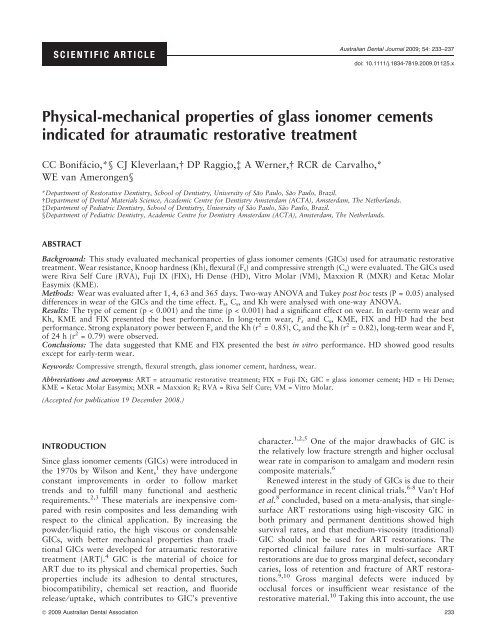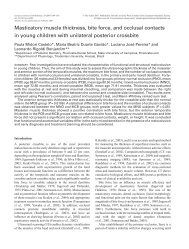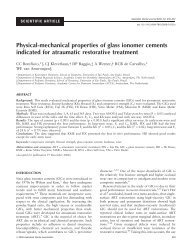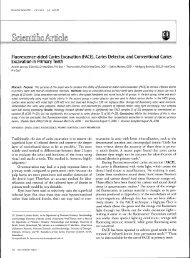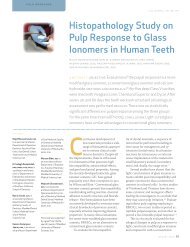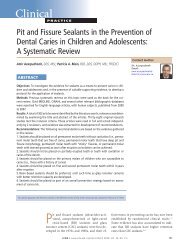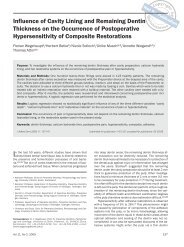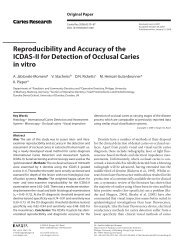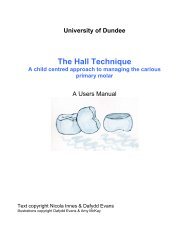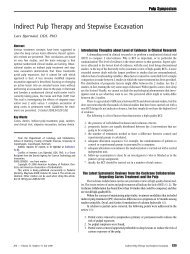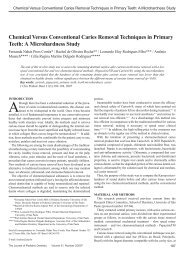Physical-mechanical properties of glass ionomer cements indicated ...
Physical-mechanical properties of glass ionomer cements indicated ...
Physical-mechanical properties of glass ionomer cements indicated ...
You also want an ePaper? Increase the reach of your titles
YUMPU automatically turns print PDFs into web optimized ePapers that Google loves.
SCIENTIFIC ARTICLE<br />
Australian Dental Journal 2009; 54: 233–237<br />
doi: 10.1111/j.1834-7819.2009.01125.x<br />
<strong>Physical</strong>-<strong>mechanical</strong> <strong>properties</strong> <strong>of</strong> <strong>glass</strong> <strong>ionomer</strong> <strong>cements</strong><br />
<strong>indicated</strong> for atraumatic restorative treatment<br />
CC Bonifácio,*§ CJ Kleverlaan, DP Raggio,à A Werner, RCR de Carvalho,*<br />
WE van Amerongen§<br />
*Department <strong>of</strong> Restorative Dentistry, School <strong>of</strong> Dentistry, University <strong>of</strong> São Paulo, São Paulo, Brazil.<br />
Department <strong>of</strong> Dental Materials Science, Academic Centre for Dentistry Amsterdam (ACTA), Amsterdam, The Netherlands.<br />
àDepartment <strong>of</strong> Pediatric Dentistry, School <strong>of</strong> Dentistry, University <strong>of</strong> São Paulo, São Paulo, Brazil.<br />
§Department <strong>of</strong> Pediatric Dentistry, Academic Centre for Dentistry Amsterdam (ACTA), Amsterdam, The Netherlands.<br />
ABSTRACT<br />
Background: This study evaluated <strong>mechanical</strong> <strong>properties</strong> <strong>of</strong> <strong>glass</strong> <strong>ionomer</strong> <strong>cements</strong> (GICs) used for atraumatic restorative<br />
treatment. Wear resistance, Knoop hardness (Kh), flexural (Fs) and compressive strength (Cs) were evaluated. The GICs used<br />
were Riva Self Cure (RVA), Fuji IX (FIX), Hi Dense (HD), Vitro Molar (VM), Maxxion R (MXR) and Ketac Molar<br />
Easymix (KME).<br />
Methods: Wear was evaluated after 1, 4, 63 and 365 days. Two-way ANOVA and Tukey post hoc tests (P = 0.05) analysed<br />
differences in wear <strong>of</strong> the GICs and the time effect. Fs, Cs, and Kh were analysed with one-way ANOVA.<br />
Results: The type <strong>of</strong> cement (p < 0.001) and the time (p < 0.001) had a significant effect on wear. In early-term wear and<br />
Kh, KME and FIX presented the best performance. In long-term wear, Fs and Cs, KME, FIX and HD had the best<br />
performance. Strong explanatory power between F s and the Kh (r 2 = 0.85), C s and the Kh (r 2 = 0.82), long-term wear and F s<br />
<strong>of</strong> 24 h (r 2 = 0.79) were observed.<br />
Conclusions: The data suggested that KME and FIX presented the best in vitro performance. HD showed good results<br />
except for early-term wear.<br />
Keywords: Compressive strength, flexural strength, <strong>glass</strong> <strong>ionomer</strong> cement, hardness, wear.<br />
Abbreviations and acronyms: ART = atraumatic restorative treatment; FIX = Fuji IX; GIC = <strong>glass</strong> <strong>ionomer</strong> cement; HD = Hi Dense;<br />
KME = Ketac Molar Easymix; MXR = Maxxion R; RVA = Riva Self Cure; VM = Vitro Molar.<br />
(Accepted for publication 19 December 2008.)<br />
INTRODUCTION<br />
Since <strong>glass</strong> <strong>ionomer</strong> <strong>cements</strong> (GICs) were introduced in<br />
the 1970s by Wilson and Kent, 1 they have undergone<br />
constant improvements in order to follow market<br />
trends and to fulfill many functional and aesthetic<br />
requirements. 2,3 These materials are inexpensive compared<br />
with resin composites and less demanding with<br />
respect to the clinical application. By increasing the<br />
powder ⁄ liquid ratio, the high viscous or condensable<br />
GICs, with better <strong>mechanical</strong> <strong>properties</strong> than traditional<br />
GICs were developed for atraumatic restorative<br />
treatment (ART). 4 GIC is the material <strong>of</strong> choice for<br />
ART due to its physical and chemical <strong>properties</strong>. Such<br />
<strong>properties</strong> include its adhesion to dental structures,<br />
biocompatibility, chemical set reaction, and fluoride<br />
release ⁄ uptake, which contributes to GIC’s preventive<br />
character. 1,2,5 One <strong>of</strong> the major drawbacks <strong>of</strong> GIC is<br />
the relatively low fracture strength and higher occlusal<br />
wear rate in comparison to amalgam and modern resin<br />
composite materials. 6<br />
Renewed interest in the study <strong>of</strong> GICs is due to their<br />
good performance in recent clinical trials. 6-8 Van’t H<strong>of</strong><br />
et al. 8 concluded, based on a meta-analysis, that singlesurface<br />
ART restorations using high-viscosity GIC in<br />
both primary and permanent dentitions showed high<br />
survival rates, and that medium-viscosity (traditional)<br />
GIC should not be used for ART restorations. The<br />
reported clinical failure rates in multi-surface ART<br />
restorations are due to gross marginal defect, secondary<br />
caries, loss <strong>of</strong> retention and fracture <strong>of</strong> ART restorations.<br />
9,10 Gross marginal defects were induced by<br />
occlusal forces or insufficient wear resistance <strong>of</strong> the<br />
restorative material. 10 Taking this into account, the use<br />
ª 2009 Australian Dental Association 233
CC Bonifácio et al.<br />
<strong>of</strong> GIC in paediatric restorative dentistry would still be<br />
adequate for the relative low occlusal forces applied to<br />
the restorations and their reduced time in the oral<br />
cavity. Furthermore, GIC releases and uptakes fluoride,<br />
adheres chemically to the tooth structure, and can be<br />
used in a variety <strong>of</strong> clinical scenarios. 11 Based on these<br />
previous arguments, special attention should be paid<br />
to the <strong>mechanical</strong> <strong>properties</strong> <strong>of</strong> GICs. Therefore, the<br />
development <strong>of</strong> a better understanding <strong>of</strong> GICs flexural<br />
and compressive strength, wear resistance and hardness<br />
is essential.<br />
The development and diffusion <strong>of</strong> restorative treatment<br />
techniques has seen dentistry manufacturers<br />
expand the number <strong>of</strong> GICs <strong>indicated</strong> for ART (high<br />
viscosity and better <strong>mechanical</strong> <strong>properties</strong> GICs). In this<br />
study, six commercially available conventional GICs<br />
were investigated. These included Ketac Molar Easymix<br />
and Fuji IX which were used as reference materials<br />
as they are the most frequently reported materials in<br />
in vivo and in vitro studies. 12–15 The aim <strong>of</strong> this study<br />
was to investigate the <strong>mechanical</strong> <strong>properties</strong> <strong>of</strong> GICs<br />
used for ART. Wear resistance, flexural and compressive<br />
strength and Knoop hardness were evaluated.<br />
MATERIALS AND METHODS<br />
The restorative GICs used in this study are listed in<br />
Table 1, together with the manufacturer and batch code<br />
data. The GICs used are hand-mixed versions and were<br />
used in accordance with the procedures supplied by the<br />
manufacturers.<br />
Three-body wear was evaluated with the ACTA wear<br />
machine. 15 This device consisted <strong>of</strong> two motor-driven<br />
cylindrical wheels rolling over each other with a surface<br />
slip <strong>of</strong> 15 per cent, inside a bowl containing a third<br />
body medium, consisting <strong>of</strong> a slurry <strong>of</strong> rice and millet<br />
seed shells (pH = 7). The specimen wheel and stainless<br />
steel were pressed against each other with a spring force<br />
<strong>of</strong> 15 N. A test run consisted <strong>of</strong> 200 000 cycles<br />
(55.5 hours) <strong>of</strong> the specimen wheel at a rotational<br />
speed <strong>of</strong> 1 Hz. 4 The specimen wheel consisted <strong>of</strong> 10<br />
compartments, each containing approximately 1 g <strong>of</strong><br />
cement. For Riva, Hi Dense, Vitro Molar and Maxxion<br />
R, two compartments were filled with the cement.<br />
Ketac Molar Easymix and Fuji IX served as reference<br />
Table 1. Materials used in this study<br />
material and therefore only one compartment was filled<br />
with these <strong>cements</strong>. The specimen’s wheel was kept wet<br />
at 37°C at all times throughout a period <strong>of</strong> one year.<br />
Four wear runs were performed on this specimen’s<br />
wheel. The first run starting six hours after preparation<br />
<strong>of</strong> the specimen and the three subsequent ones after 4,<br />
63, and 365 days. After each run, 10 tracings were<br />
taken at fixed positions on the worn surface <strong>of</strong> each pair<br />
<strong>of</strong> specimen (PRK pr<strong>of</strong>ilometer No. 720702, Perthen<br />
GmbH, Hannover, Germany) so the loss <strong>of</strong> material<br />
(lm) could be measured.<br />
The flexural strength (Fs) was measured according to<br />
the ISO Standard ISO9917-2 using 25 · 2 · 2 mm barshaped<br />
specimens (n = 10). After setting (10 minutes),<br />
the specimens were removed from the moulds and placed<br />
into 37°C paraffin. After 24 hours, the height and width<br />
<strong>of</strong> the specimens were measured using a digital micrometer<br />
to an accuracy <strong>of</strong> 0.01 mm. The specimens were<br />
subjected to a 3-point bending test (the distance between<br />
the two supports is 20.0 mm) on a universal testing<br />
machine (Mini Instron no. 4442, Instron Corp, Canton,<br />
MA, USA) at a crosshead speed <strong>of</strong> 1.0 mm ⁄ min. The Fs<br />
was calculated with the following equation:<br />
FS ¼ 3Fl<br />
2wh 2<br />
where F is the load at fracture, l the distance between<br />
the supports (20.0 mm), w the specimen width and h<br />
the specimen height. The compressive strength (Cs) was<br />
measured analogue to the flexural strength, e.g., same<br />
storage conditions, testing machine, crosshead speed<br />
and number <strong>of</strong> specimens per cement, using cylindrical<br />
specimens (n = 10) with 4 mm diameter and 6 mm<br />
height (according to the ISO Standard ISO9917-1). The<br />
Cs was calculated with the following equation:<br />
CS ¼ F<br />
1<br />
4 pd2<br />
where F is the load at fracture, d the diameter, and h the<br />
specimen height.<br />
The Knoop microhardness was determined with a<br />
hardness test machine (HM 124 – Mitutoyo, Japan)<br />
with 25 g load and a 30-second dwell time. 16 Two<br />
specimens <strong>of</strong> each GIC were prepared in PVC moulds<br />
with a diameter <strong>of</strong> 8 mm and a height <strong>of</strong> 4 mm. Each<br />
Code Product Manufacturer Colour Batch No. Expiry date<br />
RVA Riva Self Cure SDI (Bayswater, VIC, AU) A2 50303 2008 ⁄ 03<br />
FIX Fuji IX GC Europe (Leuven, BE) A3 510031 2008 ⁄ 10<br />
HD Hi Dense Sh<strong>of</strong>u (Ratingen, GE) * 100630-5 2012 ⁄ 10<br />
VM Vitro Molar DFL (Rio de Janeiro, BR) * 5070823 2007 ⁄ 07<br />
MXR Maxxion R FGM (Joinville, SC, BR) A2 200706 2008 ⁄ 07<br />
KME Ketac Molar Easymix 3M ⁄ ESPE (Seefeld, GE) A3 243914 2007 ⁄ 10<br />
*There was no colour specification.<br />
234 ª 2009 Australian Dental Association
hole was filled with a small excess <strong>of</strong> cement and after<br />
10 minutes the specimens were stored in paraffin for<br />
24 hours at 37°C. 17 Prior to testing, the specimens were<br />
polished with 1200 grit paper (Buehler) until the excess<br />
was removed. Five indentations were taken in two<br />
specimens (n = 10).<br />
Two-way ANOVA and Tukey post hoc tests (p =<br />
0.05) were used to test differences in wear <strong>of</strong> the GICs<br />
and the effect <strong>of</strong> time. The flexural strength, compressive<br />
strength and Knoop microhardness were analysed<br />
with one-way ANOVA. Regression analysis was used in<br />
order to find the explanatory power (r 2 ) <strong>of</strong> each tested<br />
<strong>properties</strong> over another. The s<strong>of</strong>tware used was Sigma<br />
Stat 3.1 (SPSS Inc., Chicago, USA).<br />
RESULTS<br />
The wear <strong>of</strong> different hand-mixed GICs are summarized<br />
in Table 2 and graphically depicted in Fig 1.<br />
Two-way ANOVA showed that the type <strong>of</strong> cement<br />
(F = 2371.7; p < 0.001) and the time (F = 2965.6;<br />
p < 0.001) had a significant effect on wear. Tukey<br />
post hoc test (p < 0.05) showed that cement wear<br />
decreased significantly for all time spans measured in<br />
the one-year period.<br />
Ketac Molar Easymix presented the lowest wear in<br />
comparison to the other materials, with significant<br />
difference in the 4 and 63 days time-frames. For the<br />
early-term wear test (1 day), Ketac Molar Easymix and<br />
Fuji IX had the lowest wear rate, and Vitro Molar and<br />
Hi Dense the highest. On the other hand, for the oneyear<br />
time-frame the best performance was found for<br />
Ketac Molar Easymix, Fuji IX and Hi Dense.<br />
The flexural and compressive strength together with<br />
the Knoop hardness are summarized in Table 3.<br />
One-way ANOVA showed significant difference for<br />
Fs (F = 9.2; p < 0.001), Cs (F = 4.8; p = 0.001) and<br />
Knoop hardness (F = 24.3; p < 0.001). The highest<br />
flexural and compressive strength was achieved by<br />
Ketac Molar Easymix, Fuji IX and Hi Dense, respectively.<br />
Both Riva and Vitro Molar had low flexural and<br />
compressive strength. Maxxion R performed well in<br />
the strength tests, showing no statistical significant<br />
difference in the flexural strength in relation to Ketac<br />
Molar Easymix, Fuji IX, Hi Dense and Riva. For the<br />
compressive strength Maxxion R test, results were<br />
different only from Ketac Molar Easymix. The Knoop<br />
hardness <strong>of</strong> Ketac Molar Easymix and Fuji IX was<br />
significantly higher than the other <strong>cements</strong>. Vitro Molar<br />
and Riva showed the lower Knoop hardness. A strong<br />
explanatory power between the flexural strength and<br />
the Knoop hardness (r 2 = 0.85) and the compressive<br />
strength and the Knoop hardness (r 2 = 0.82) was<br />
observed. The explanatory power between the flexural<br />
and compressive strength was lower (r 2 = 0.61). An<br />
even smaller explanatory power between the wear at<br />
day 1 and the flexural strength, compressive strength<br />
and the Knoop hardness was found (r 2 < 0.52). The<br />
long-term wear after one year showed a strong<br />
Table 2. Mean wear and standard deviation in parentheses (lm) at different time periods for the<br />
investigated materials<br />
Day Riva Fuji IX Hi Dense Vitro Molar Maxxion R Ketac Molar Easymix<br />
1 124.2 (11.8) 105.0 (2.7) a<br />
184.7 (19.7) 198.8 (9.0) 146.2 (6.9) 100.9 (1.1) a<br />
4 99.3 (11.3) 85.8 (4.1) 225.9 (5.1) 185.0 (7.3) 111.0 (2.1) 74.4 (1.1)<br />
63 79.0 (2.1) bc<br />
74.2 (2.2) c<br />
84.4 (6.7) b<br />
n ⁄ a 80.0 (4.7) bc<br />
57.7 (1.6)<br />
365 60.6 (9.6) 44.5 (1.8) d<br />
44.4 (1.6) d<br />
123.2 (2.1) 68.8 (9.8) 44.9 (4.8) d<br />
Means with the same letter are not significantly different (p > 0.05).<br />
Fig 1. Wear in lm per 200 000 cycles on the investigated materials<br />
at slip <strong>of</strong> 15% and 15 N force.<br />
Table 3. Mean flexural strength (F s in MPa),<br />
compressive strength (C s in MPa) and the Knoop<br />
hardness (in MPa), and standard deviations in<br />
parentheses for the investigated materials (after<br />
24 hours)<br />
Material Flexural<br />
strength (Fs)<br />
Riva 23.9 (10.7) ab<br />
Fuji IX 33.3 (6.1) c<br />
Hi Dense 33.3 (3.9) c<br />
Vitro Molar 19.2 (4.0) a<br />
Maxxion R 29.5 (3.6) bc<br />
Ketac Molar 34.5 (7.2) c<br />
Easymix<br />
<strong>Physical</strong>-<strong>mechanical</strong> <strong>properties</strong> <strong>of</strong> GICs<br />
Compressive<br />
strength (Cs)<br />
126.5 (18.5) a<br />
166.7 (31.3) ab<br />
159.2 (26.7) ab<br />
135.7 (48.3) a<br />
130.3 (23.2) a<br />
177.8 (28.2) b<br />
Knoop<br />
hardness (Kh)<br />
38.7 (12.9) ab<br />
68.7 (10.9) d<br />
55.8 (11.5) c<br />
37.0 (5.5) a<br />
50.4 (5.3) bc<br />
73.8 (9.4) d<br />
Means with the same letter, within Fs, Cs or Kh are not significantly<br />
different (p > 0.05).<br />
ª 2009 Australian Dental Association 235
CC Bonifácio et al.<br />
explanatory power with the flexural strength <strong>of</strong><br />
24 hours (r 2 = 0.79). No other strong explanatory<br />
coefficients were found.<br />
DISCUSSION<br />
The hand-mixed GICs were chosen for this study as<br />
they are commonly used in clinical situations with a<br />
lack <strong>of</strong> electricity. In contrast, encapsulated <strong>cements</strong><br />
were dispensed beforehand, which minimized operatorinduced<br />
variability. As the mixing is automatic in this<br />
type <strong>of</strong> GIC, it is possible to add more powder in the<br />
mixture, resulting in better <strong>mechanical</strong> <strong>properties</strong>, as<br />
was suggested in a previous study 4 . Some <strong>of</strong> the GICs<br />
used in this study are not available in an encapsulated<br />
version, therefore, for standardization all GICs used<br />
were hand-mixed versions.<br />
The effectiveness <strong>of</strong> single-surface ART restorations<br />
is already evidence-based 7,8 as the survival rates for the<br />
high viscosity GICs reached very acceptable levels.<br />
However, for multi-surface restorations the survival<br />
rates are reported to be less satisfactory (12 to 76<br />
per cent). 6,10,18 The most common reasons given for<br />
ART class II GIC restoration failures are gross marginal<br />
defect, loss <strong>of</strong> retention, fracture <strong>of</strong> ART restorations<br />
and secondary caries. 9,10,13,14 In a study carried out<br />
under ideal clinical conditions, the main reason for<br />
failure <strong>of</strong> class II restorations in permanent teeth was<br />
the loss <strong>of</strong> GIC in the proximal area, leading to loss <strong>of</strong><br />
proximal contact. 6 Based on this evidence, the search<br />
for materials with strong <strong>mechanical</strong> <strong>properties</strong> is<br />
necessary in order to accomplish better survival rates<br />
with multi-surface ART restorations. The current study<br />
evaluated flexural and compressive strength, as well as<br />
the Knoop hardness and wear resistance for GICs,<br />
characteristics that are useful in identifying appropriate<br />
materials for ART.<br />
When studying the wear resistance <strong>of</strong> GICs, de Gee<br />
et al. 15 found high early wear rates with different GICs<br />
compared with the present study. The authors observed<br />
that wear rates declined over time and a reduction in<br />
wear was still evident even between 4 months and<br />
1 year. Our results also showed decreasing values from<br />
the first to the last experiment with the exception <strong>of</strong> Hi<br />
Dense between 1 day and 4 days. The reason for a high<br />
value for the 4 days measurement <strong>of</strong> Hi Dense can be<br />
explained by its composition. 23 Hi Dense is a silver<br />
reinforced GIC. The silver particles in the powder<br />
interfere in the setting reaction, making it lengthy.<br />
Concurrently, the final mixture is also thought to suffer<br />
from a lack <strong>of</strong> cohesion. Therefore, it is assumed that<br />
the interfacial bonding between the particles and the<br />
polymer matrix can be influenced by the different<br />
powder particles. 16 This could be why Hi Dense<br />
presented high wear test results in the first experiments.<br />
But even with these characteristics in the early-term<br />
wear, Hi Dense presented similar wear rates to the<br />
reference material in the long-term. Preliminary studies<br />
have shown that highly viscous GICs have either<br />
comparable or superior <strong>mechanical</strong> <strong>properties</strong> and wear<br />
resistance to metal-reinforced <strong>cements</strong>. 22,24 The Vitro<br />
Molar wear at two months (63 days) could not be<br />
measured due to failure <strong>of</strong> the specimen reference. In<br />
the wear experiment, approximately 80 per cent <strong>of</strong> the<br />
surface <strong>of</strong> the specimen wheel was subjected to threebody<br />
wear by the antagonist wheel, leaving two unworn<br />
ridges on the sides <strong>of</strong> the specimen wheel. These unworn<br />
ridges serve as references. If the investigated material is<br />
weak or has a very high wear rate, fracture <strong>of</strong> such a<br />
ridge is sometimes observed. This fact can be translated<br />
to a clinical situation where the restoration will fail<br />
because <strong>of</strong> a fracture or a large loss <strong>of</strong> material.<br />
Compressive strength is <strong>of</strong>ten used as a measure <strong>of</strong><br />
the ability <strong>of</strong> a material to withstand masticatory<br />
forces. The obtained compressive strength for Ketac<br />
Molar Easymix and Fuji IX matched with previous<br />
reported values, 19 but were lower compared to values<br />
obtained by Peez and Frank. 20 The 3-point bending test<br />
can be regarded as representative <strong>of</strong> a clinical situation<br />
<strong>of</strong> the forces exerted by the opposing cusp. 21 The<br />
flexural strength values found, corresponded well with<br />
previous reported values. 22<br />
Nevertheless, the low flexural strength for Riva and<br />
Maxxion R <strong>of</strong> 23.9 and 19.2 MPa, respectively, can be<br />
viewed as the Achilles heel <strong>of</strong> these materials when used<br />
in multi-surface restorations. The microhardness can be<br />
defined as the resistance <strong>of</strong> a material to indentation or<br />
penetration. In concordance with the flexural strength,<br />
the hardness <strong>of</strong> Riva and Maxxion R was also<br />
significantly lower than the other materials studied.<br />
The reported microhardness values <strong>of</strong> Xie et al., 16<br />
which investigated the Knoop hardness for similar<br />
materials with the same methods but a storage time<br />
<strong>of</strong> 7 days, were higher than our values. This can be<br />
explained by the longer storage line.<br />
A weak explanatory power was found between<br />
flexural and compressive strengths; this finding is in<br />
line with Xie et al. 16 Between the long-term wear and<br />
the flexural strength a strong explanatory power was<br />
found, suggesting that it is possible to forecast the longterm<br />
wear by using the flexural strength results.<br />
The ART technique was developed, in principle, for<br />
areas that lack electricity, in underprivileged communities<br />
<strong>of</strong> developing countries. 25 Considering the success<br />
<strong>of</strong> single surface ART restorations, the technique<br />
has spread throughout the public dental health service<br />
and academic areas.<br />
CONCLUSIONS<br />
Within the limitations <strong>of</strong> this in vitro study, Ketac<br />
Molar Easymix and Fuji IX presented the best<br />
236 ª 2009 Australian Dental Association
performance in all the tests. Hi Dense, the metal<br />
reinforced GIC, although presenting good strength<br />
results, showed very weak wear resistance. The worst<br />
performance was found for Vitro Molar. As Maxxion<br />
R achieved, in general, a satisfactory performance in<br />
comparison to Ketac Molar Easymix and Fuji IX, this<br />
material should be evaluated in clinical situations. The<br />
manufacturer should improve this material in order to<br />
make it possible for use on a larger scale by applying it<br />
in social projects, clinical research and public dental<br />
health services.<br />
REFERENCES<br />
1. Wilson AD, Kent BE. A new translucent cement for dentistry. The<br />
<strong>glass</strong> <strong>ionomer</strong> cement. Br Dent J 1972;132:133–135.<br />
2. Mount GJ. A colour atlas <strong>of</strong> <strong>glass</strong>-<strong>ionomer</strong> <strong>cements</strong>. 2nd edn.<br />
London: Martin Dunitz, 1994.<br />
3. Imparato JCP, Garcia A, Bonifacio CC, Raggio DP, Mendes FM,<br />
Vedovello Filho M. Color stability <strong>of</strong> esthetic ion-releasing<br />
restorative materials subjected to pH variation. ASDC J Dent<br />
Child 2007;74:189–193.<br />
4. van Duinen RN, Kleverlaan CJ, de Gee AJ, Werner A, Feilzer AJ.<br />
Early and long-term wear <strong>of</strong> ‘fast-set’ conventional <strong>glass</strong>-<strong>ionomer</strong><br />
<strong>cements</strong>. Dent Mater 2005;21:716–720.<br />
5. AB-Ghani Z, Ngo H, McIntyre J. Effect <strong>of</strong> remineralization<br />
⁄ demineralization cycles on mineral pr<strong>of</strong>iles <strong>of</strong> Fuji IX fast<br />
in vitro using electron probe microanalysis. Aust Dent J 2007;52:<br />
276–281.<br />
6. Scholtanus JD, Huysmans MC. Clinical failure <strong>of</strong> class-II restorations<br />
<strong>of</strong> a highly viscous <strong>glass</strong>-<strong>ionomer</strong> material over a 6-year<br />
period: a retrospective study. J Dent 2007;35:156–162.<br />
7. Frencken JE, van’t H<strong>of</strong> MA, van Amerongen WE, Holmgren CJ.<br />
Effectiveness <strong>of</strong> single-surface ART restorations in the permanent<br />
dentition: a meta-analysis. J Dent Res 2004;83:120–123.<br />
8. van’t H<strong>of</strong> MA, Frencken JE, van Palenstein Helderman WH,<br />
Homgren CJ. The atraumatic restorative treatment (ART)<br />
approach for managing dental caries: a meta-analysis. Int Dent<br />
J 2006;56:345–351.<br />
9. Yip HK, Smales RJ, Ngo HC, Tay FR, Chu FC. Selection <strong>of</strong><br />
restorative materials for the atraumatic restorative treatment<br />
(ART) approach: a review. Spec Care Dentist 2001;21:216–221.<br />
10. van Gemert-Schriks MCM, van Amerongen WE, ten Cate JM,<br />
Aartman IHA. Three-year survival <strong>of</strong> single- and two-surface<br />
ART restorations in a high-caries child population. Clin Oral<br />
Invest 2007;11:337–343.<br />
11. Berg JH. Glass <strong>ionomer</strong> <strong>cements</strong>. Pediatr Dent 2002;24:430–<br />
438.<br />
12. Mickenautsch S, Rudolph MJ, Ogunbodede EO, Frencken JE.<br />
The impact <strong>of</strong> the ART approach on the treatment pr<strong>of</strong>ile in a<br />
<strong>Physical</strong>-<strong>mechanical</strong> <strong>properties</strong> <strong>of</strong> GICs<br />
mobile dental system (MDS) in South Africa. Int Dent J<br />
1999;49:132–138.<br />
13. Taifour D, Frencken JE, Beiruti N, van’t H<strong>of</strong> MA, Truin GJ.<br />
Effectiveness <strong>of</strong> <strong>glass</strong> <strong>ionomer</strong> (ART) and amalgam restorations<br />
in the deciduous dentition: results after 3 years. Caries Res<br />
2002;36:437–444.<br />
14. Yip KH, Smales RJ, Gao W, Peng D. The effects <strong>of</strong> two cavity<br />
preparation methods on the longevity <strong>of</strong> <strong>glass</strong> <strong>ionomer</strong> cement<br />
restorations: an evaluation after 12 months. J Am Dent Assoc<br />
2002;133:744–751.<br />
15. de Gee AJ, van Duinen RN, Werner A, Davidson CL. Early and<br />
long-term wear <strong>of</strong> conventional and resin-modified <strong>glass</strong> <strong>ionomer</strong><br />
<strong>cements</strong>. J Dent Res 1996;75:1613–1619.<br />
16. Xie D, Brantley WA, Culbertson BM, Wang G. Mechanical<br />
<strong>properties</strong> and microstructures <strong>of</strong> <strong>glass</strong> <strong>ionomer</strong> <strong>cements</strong>. Dent<br />
Mater 2000;16:129–138.<br />
17. Kleverlaan CJ, van Duinen RNB, Feilzer AJ. Mechanical <strong>properties</strong><br />
<strong>of</strong> <strong>glass</strong> <strong>ionomer</strong> <strong>cements</strong> affected by curing methods. Dent<br />
Mater 2004;20:45–50.<br />
18. van de Hoef N, van Amerongen E. Influence <strong>of</strong> local anesthesia<br />
on the quality <strong>of</strong> class II <strong>glass</strong> <strong>ionomer</strong> restorations. Int J Paediatr<br />
Dent 2007;17:239–247.<br />
19. Algera TJ, Kleverlaan CJ, Prahl-Andersen B, Feilzer AJ. The<br />
influence <strong>of</strong> environmental conditions on the material <strong>properties</strong><br />
<strong>of</strong> setting <strong>glass</strong>-<strong>ionomer</strong> <strong>cements</strong>. Dent Mater 2006;22:852–<br />
856.<br />
20. Peez R, Frank S. The physical-<strong>mechanical</strong> performance <strong>of</strong> the new<br />
Ketac TM Molar Easymix compared to commercially available<br />
<strong>glass</strong> <strong>ionomer</strong> restoratives. J Dent 2006;34:582–587.<br />
21. Mitra SB, Kedrowski BL. Long-term <strong>mechanical</strong> <strong>properties</strong> <strong>of</strong><br />
<strong>glass</strong> <strong>ionomer</strong>s. Dent Mater 1994;10:78–82.<br />
22. Peutzfeldt A. Compomers and <strong>glass</strong> <strong>ionomer</strong>s: bond strength to<br />
dentin and <strong>mechanical</strong> <strong>properties</strong>. Am J Dent 1996;9:259–<br />
263.<br />
23. Yap AU. Effects <strong>of</strong> storage, thermal and load cycling on a new<br />
reinforced <strong>glass</strong>-<strong>ionomer</strong> cement. J Oral Rehabil 1998;25:40–<br />
44.<br />
24. Yap AU, Teo JC, Teoh SH. Comparative wear resistance <strong>of</strong><br />
reinforced <strong>glass</strong> <strong>ionomer</strong> restorative materials. Oper Dent 2001;<br />
26:343–348.<br />
25. Anusavice KJ. Does ART have a place in preservative dentistry?<br />
Community Dent Oral Epidemiol 1999;27:442–448.<br />
Address for correspondence:<br />
Clarissa Calil Bonifácio<br />
ACTA – Pedodontology<br />
Louwesweg, 1<br />
1066 Amsterdam<br />
The Netherlands<br />
Email: C.Bonifacio@acta.nl<br />
ª 2009 Australian Dental Association 237


